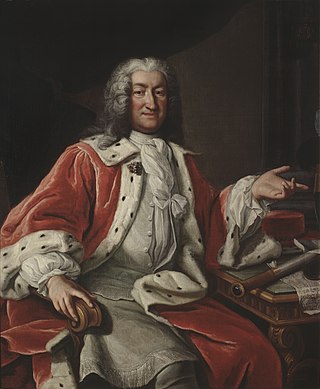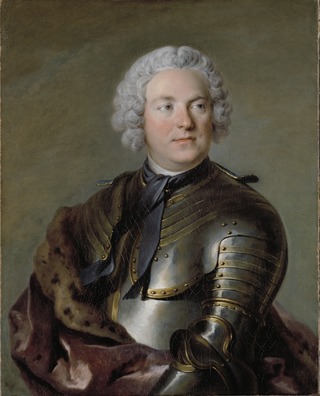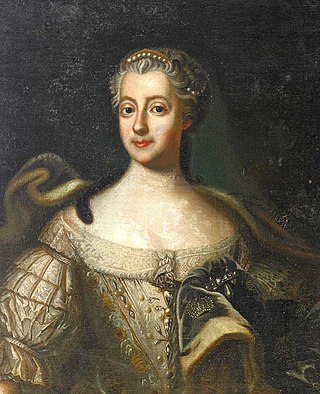
Adolf Frederick, or Adolph Frederick was King of Sweden from 1751 until his death in 1771. He was the son of Christian August of Holstein-Gottorp, Prince of Eutin, and Albertina Frederica of Baden-Durlach. He was an uncle of Catherine the Great and husband to Louisa Ulrika of Prussia.

Ulrika Eleonora or Ulrica Eleanor, known as Ulrika Eleonora the Younger, reigned as Queen of Sweden from 5 December 1718 until her abdication on 29 February 1720 in favour of her husband Frederick. Following her husband's accession as King Frederick I, Ulrika Eleonora served as his queen consort until her death in 1741.

The monarchy of Sweden is centred on the monarchical head of state of Sweden, by law a constitutional and hereditary monarchy with a parliamentary system. There have been kings in what now is the Kingdom of Sweden for more than a millennium. Originally an elective monarchy, it became a hereditary monarchy in the 16th century during the reign of Gustav Vasa, though virtually all monarchs before that belonged to a limited and small number of political families which are considered to be the royal dynasties of Sweden.

Baron Jacob Magnus Sprengtporten (1727–1786) was a Swedish-Finnish army officer and politician, and half-brother of Georg Magnus Sprengtporten. He is most famous as one of the leaders of the Revolution of 1772, the coup d'état which ended the age of constitutional monarchy in Sweden known as the Age of Liberty and ushered in the period of absolute monarchy known as the Gustavian era.

Count Arvid Bernhard Horn af Ekebyholm was a Swedish general, diplomat and politician, a member of the noble Horn family. He served twice as President of the Privy Council Chancellery and was one of the leading figures of the Swedish Age of Liberty.

The 1809 Instrument of Government, adopted on 6 June 1809 by the Riksdag of the Estates and King Charles XIII, was the constitution of the Kingdom of Sweden from 1809 to the end of 1974. It came about as a result of the Coup of 1809, in which King Gustav IV Adolf was deposed. The promulgation of the constitution marks the point at which Sweden transitioned from the absolute monarchy of the Gustavian era into a stable, constitutional monarchy adhering to the rule of law and significant civil liberties.
The Hats were a Swedish political faction active during the Age of Liberty (1719–1772). Their name derives from the tricorne hat worn by officers and gentlemen. They vied for power with the opposing Caps party. In 18th century Swedish politics, the Hats represented conservatives, the Caps represented liberals. The Hats, who ruled Sweden from 1738 to 1765, advocated an alliance with France and an assertive foreign policy, especially towards Russia. During their tenure, they involved Sweden in two expensive and disastrous wars, in the 1740s and 1750s.

Louisa Ulrika of Prussia was Queen of Sweden from 1751 to 1771 as the wife of King Adolf Frederick. She was queen mother during the reign of King Gustav III.

The 1772 Instrument of Government was the constitution of the Kingdom of Sweden from 1772 to 1809. It was promulgated in the wake of the Revolution of 1772, a self-coup mounted by King Gustav III, and replaced the 1720 Instrument of Government, which had been in force for most of the Age of Liberty (1719-72). Although in theory the 1772 Instrument merely readjusted the balance of power between the Crown and the Riksdag of the Estates, without changing Sweden's status as a constitutional monarchy, in practice it is generally seen as instituting an absolute monarchy, especially after its modification in 1789 by the Union and Security Act, which further strengthened royal power at the expense of the Riksdag. It remained in force throughout the Gustavian era, until replaced by the 1809 Instrument of Government as a result of the Coup of 1809.

Count Carl Gustaf Tessin was a Swedish Count and politician and son of architect Nicodemus Tessin the Younger and Hedvig Eleonora Stenbock. He was one of the most brilliant personages of his day, and the most prominent representative of French culture in Sweden. He was also often considered a fine orator.

Ulrika Eleonora Strömfelt, was a politically active Swedish noble and courtier. She is known for her part in the attempted Coup d'état of queen Louisa Ulrika in 1756.

Events from the year 1756 in Sweden

The Coup of 1756 was an attempted coup d'état planned by Queen Louisa Ulrika of Sweden to abolish the rule of the Riksdag of the Estates and reinstate absolute monarchy in Sweden. The attempted coup was exposed and subdued in 1756 shortly before it was due to be put in action. It caused a rift between the royal house and the parliament.

The Revolution of 1772, also known as The Bloodless Revolution or the Coup of Gustav III, was a Swedish coup d'état performed by King Gustav III of Sweden on 19 August 1772 to introduce a division of power between the king and the Riksdag of the Estates, resulting in the end of the Age of Liberty and the introduction of the Swedish Constitution of 1772, which would strengthen the power of the monarch.

The Gustavians were a political faction in the Kingdom of Sweden who supported the absolutist regime of King Gustav III of Sweden, and sought after his assassination in 1792 to uphold his legacy and protect the interests of his descendants of the House of Holstein-Gottorp.

The 1719 Instrument of Government adopted on 21 February 1719 by the Riksdag of the Estates, was the constitution of the Kingdom of Sweden from 1719 to 1720. Although only in force for a few months, it has great significance in Swedish history, as its promulgation marked the end of the country's first period of absolutism (1680-1719) and the beginning of the period of constitutional monarchy and parliamentary government traditionally known as the Age of Liberty.

Erik Brahe, was a Swedish count. He was executed for treason as one of the conspirators participating in the failed coup d'etat of queen Louisa Ulrika, the Coup of 1756.
The Holstein Party, was the name of a political group in 18th-century Sweden which played a significant role in politics after the death of Charles XII of Sweden in 1718 and until 1727.

December Crisis (1768) was a political crisis which occurred in Sweden in December 1768 when Adolf Frederick, King of Sweden, demonstrated against his limited powers by refusing to sign state documents, thereby paralyzing the government and bringing about a new Riksdag of the Estates.

The 1720 Instrument of Government adopted on 2 May 1720 by the Riksdag of the Estates, was the constitution of the Kingdom of Sweden from 1720 to 1772, and was thus in force for almost the entirety of the period of constitutional monarchy known as the Age of Liberty, having replaced the largely identical Instrument of Government (1719).


















